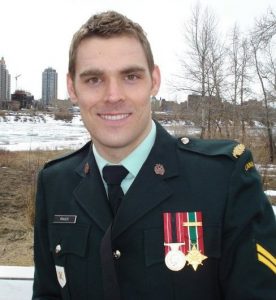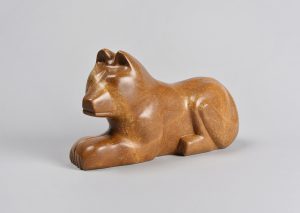Finding Healing in a Soapstone Wolf
The brutality of war
The experiences of war can be brutal and cruel; challenging the human spirit to its very core. Corporal Barrett Fraser, a soldier of the Calgary Highlanders knows this reality first-hand. He was seriously wounded near Kandahar, Afghanistan on December 30, 2009.
The devastating explosion that changed Fraser’s life happened while he was in a military vehicle patrol. One of the largest improvised explosive devices used against Canadians in Afghanistan blew up under the vehicle beside him.
The blast killed journalist Michelle Lang, and four Canadian soldiers: Private Garrett Chidley, Sergeant George Miok, Corporal Zachery McCormack and Sergeant Kirk Taylor.
The long road to recovery
Surviving the devastating loss of his close friends, and suffering serious physical injuries set Fraser on a long, tough journey towards psychological and physical healing.
During his difficult recovery in Edmonton, Fraser’s health care team suggested that he should be around other people and work with his hands to help his healing. His psychiatrist specifically suggested he should take art classes – but he was hesitant and doubtful that it would help.
Activities to support wounded soldiers
The Canadian Army treats wounded soldiers at special facilities such as the one in Edmonton where Corporal Fraser convalesced. Along with medical care, these facilities offer classes in everything from painting and carving to activities such as gardening and fly-fishing.
The interactive programs have proven to be an important part of physical and emotional therapy for soldiers suffering from Post-Traumatic Stress Disorder (PTSD).
In 2010, approximately six months after Fraser’s harrowing incident, he agreed to attend a soapstone carving class taught by an artist volunteer from the program. At the time, he did not realize how much this simple choice would affect his recovery.
The wolf- a symbol for recovery
This class, held for a few hours once a week in north Edmonton and included aided transportation (he was still using a wheelchair during this time), also offered all the materials and tools required to make a work of art.
Fraser chose to make a symbol that would manifest the spirit he desired to have during his recovery. He chose a wolf, which he felt was a strong, smart and tenacious animal. To him, this animal was a fitting choice for someone like him- someone that refused to give up in the middle of troubling psychological and physical trials.
Thinking of this class, and his experience with it, Fraser states, “It definitely helped me at the time when I was up in Edmonton. I was up there for just over two years in and out of surgeries. It was good because it was productive and it kept my spirits up.”
Craft and battle recovery: a long work in progress
Today, as he looks on the carvings he made during this class, Fraser says, “They remind me of that time while I was doing all my recoveries. I was in and out of hospital. I had sixteen surgeries. It seemed like I was always in recovery, and it was pretty dark days.I lost my friends, and it was in that time period that it helped me get my mind off things and stay positive. Now the pieces remind me of that time and all I went through and to be positive and not be weak or give up.”
Making craft objects and recovering from battlefield wounds both take a long time. Bringing the two together at the same time makes the resulting art work a symbol of the recovery process. The resulting object is not just, for example, a wolf sculpture. Instead, the craft is connected to the perseverance that healing requires
The quotes in this text are from a 2015 discussion Corporal Barrett Fraser had with Julia and Yolande Krueger.
If you would like to see more trench art and other Canadian war-related craft, click here.



